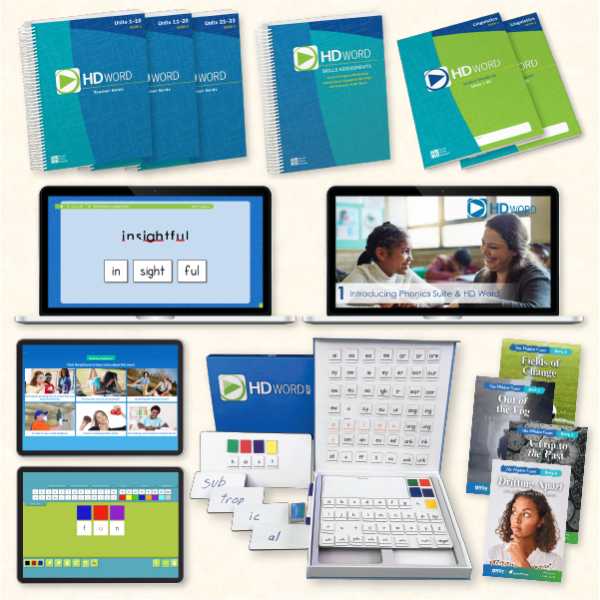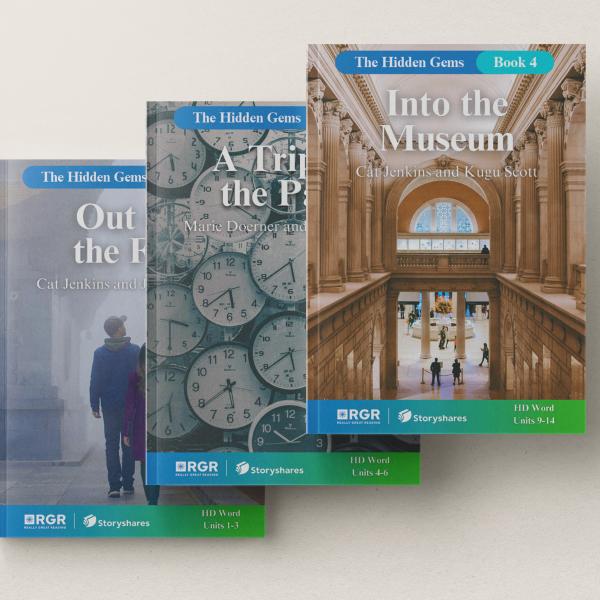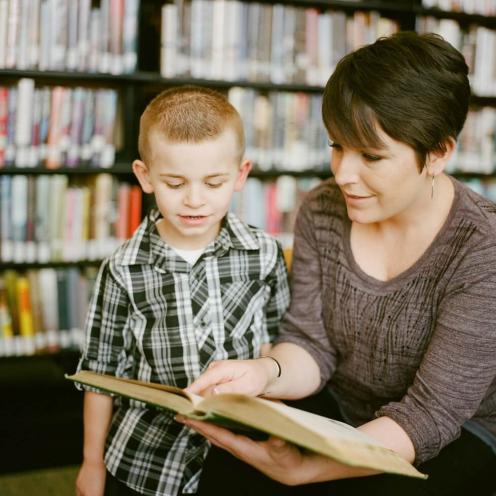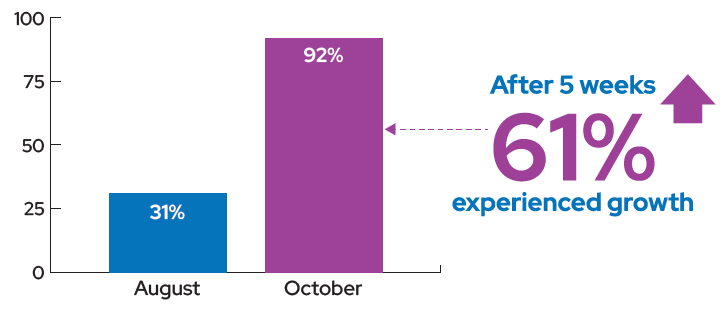Reading Intervention for Grades 6-12
An evidence-based and research-proven program developed for middle and high school students.

Experience a rigorous and effective literacy program that respects adolescent maturity and elevates engagement, while aligning with the principles of Multi-Tiered Systems of Support (MTSS). Our structured, responsive approach leverages data-based decision making to prioritize proven best practices and equips students with the foundational reading, fluency, and academic vocabulary skills essential for success in high school coursework, career pathways, and post-secondary education.
Designed to support learners who are below grade level or at risk of not meeting College- and Career-Ready Standards, the program addresses phonics and vocabulary gaps, builds multisyllabic word reading skills, and equips learners with strategies for tackling complex texts. Proven to enhance outcomes by 60% in just five weeks, this approach fosters student independence, boosts confidence, and inspires a positive attitude toward academic achievement.
For more than 20 years, Really Great Reading has been committed to adolescent literacy, offering struggling readers in middle and high school a path to progress built on respect, research, and results. Originally developed as a targeted solution for older students, our approach remains true to those roots, merging phonics-based decoding with robust visual vocabulary and comprehension work, and enriched by age-appropriate, decodable chapter books. Powered by the Science of Reading, our engaging lessons and flexible digital tools help make learning manageable for students and instructional delivery seamless for teachers. With just-in-time professional learning embedded throughout, educators grow right alongside their students, making real, measurable gains accessible to all.
Delivers measurable progress in a matter of weeks while fostering a proven, more positive attitude toward learning, preventing deeper gaps in learning
Reinforces critical decoding competencies and builds bridges to reading with user-friendly lessons that maximize classroom time and build educators’ capacity
Systematic instruction empowers students to become confident, independent readers, ready to tackle complex academic texts
A blend of visuals, manipulatives, decodable books, and digital experiences captivates students while they master new skills, preventing further harmful delays
Clear, actionable assessments and scaffolded lessons help educators identify skill gaps and deliver targeted instruction, supporting effective, tiered literacy intervention within an MTSS framework
Built-in training, coaching opportunities, clear guidance, and aligned resources remove barriers, strengthen educator practice, and ensure students stay on track toward literacy goals
Decoding for Fluency

Incorporating RGR’s research-backed and ESSA-validated literacy solution, HD Word, the program employs a systematic, explicit, multi-sensory approach to address decoding challenges in secondary, while respecting learners’ maturity and interests.
- Flexible Implementation: With print and digital tools as well as multimodal practice opportunities, the program supports small-group and one-on-one sessions
- Made for Today’s Learners: Systematic phonics instruction builds students’ ability to decode complex words confidently, making advanced word learning accessible to all
- Cumulative Practice: Provides extensive review and reinforcement of taught concepts for stronger retention and application across subject areas
- Turning Time into Impact: With built-in professional support, micro-PD, and flexible digital components, this intervention maximizes every minute of instructional time
Vocabulary Made Visual

Vocabulary acquisition is a critical skill for reading comprehension. To promote deep word learning, RGR’s adolescent reading intervention incorporates InferCabulary, an evidence-based visual vocabulary program that teaches learners the deeper meaning of texts, cultivating the robust vocabulary necessary for academic success at school and beyond. Instruction strategically connects words with concepts by front-loading target vocabulary and utilizing semantic reasoning, which supports deeper meaning, critical thinking, and comprehensive understanding.
- Ownership and Engagement: Students gain control over their vocabulary growth, enhancing their confidence in reading, fluency, comprehension, and written expression
- Integrated Approach: With direct instruction in vocabulary, inferencing, summarization, and sentence structure, students who struggle with comprehension gain confidence
- Extensive Word Library: 500+ literature titles and a variety of word categories, including 600+ SAT words, customizable to meet specific goals
- Leveraging Words that Matter: Target words can be selected by grade level, literature title, or subject, and easily extracted from any digital resource, including websites, program files, or online curricula, saving planning time and facilitating assignments
Comprehension with Confidence

Fluency and comprehension flourish when students see themselves in the stories they read. A core part of the adolescent intervention is the Hidden Gems, a chapter book series that features age-appropriate, phonics-aligned texts with relatable characters and engaging plots for middle and high school learners. Identity-rich narratives that pass the backpack test integrate explicit instruction in vocabulary, morphology, summarization, and sentence structure, building academic stamina and the confidence to thrive across subjects.
- Vocabulary and Morphology in Context: Students encounter Tier II, content-specific terms, and morphemes as part of the story and accompanying lessons, strengthening decoding, word-building, and comprehension through meaningful practice
- Structured, Engaging Practice: Activities such as partner discussions, oral summaries, group work, and sentence-level exercises promote fluency, syntactic awareness, and authentic language use
- Rigorous Routines for Academic Success: Systematic note-taking, evidence citation, summarization, and analysis of character motivation foster habits of precision, accountability, and critical thinking
- Confidence and Voice: Repeated readings, performance, and peer coaching help students master pitch, expression, and phrasing, building communication skills and a genuine love of reading
Assessment Fuels Growth

The program’s built-in, reliable assessments help teachers quickly identify skill gaps and adjust instruction in real time without extensive prep or training, while simple-to-interpret reports and data insights enable teachers to make real-time instructional decisions and track student growth. Aligned with the curriculum, the easy-to-administer assessments provide actionable insights, making it simple to identify gaps and support every learner. Combined with the Grouping Matrix, a powerful tool that makes data-driven grouping easy, the assessments streamline data analysis and intervention planning.
- Mastery measurement offers visibility and peace of mind
- Input, analysis, and tracking of progress data made easy
- Supports MTSS, intervention planning, and differentiation
Multilingual Learner Supports

Learning to speak and read in a new language can be challenging. That’s why RGR offers easy-to-use digital and printable resources helping all learners, including those new to English, build foundational skills and connect language development to reading comprehension.
Multilingual students, from newcomers to long-term English learners, thrive on the path to English literacy with this effective intervention.
By focusing on learners’ strengths and offering explicit instruction, scaffolded practice, and culturally responsive materials, our program ensures adolescent ELs gain the confidence, language skills, and comprehension strategies needed to build their way to English language and literacy proficiency and thrive beyond academics!

Incorporating RGR’s research-backed and ESSA-validated literacy solution, HD Word, the program employs a systematic, explicit, multi-sensory approach to address decoding challenges in secondary, while respecting learners’ maturity and interests.
- Flexible Implementation: With print and digital tools as well as multimodal practice opportunities, the program supports small-group and one-on-one sessions
- Made for Today’s Learners: Systematic phonics instruction builds students’ ability to decode complex words confidently, making advanced word learning accessible to all
- Cumulative Practice: Provides extensive review and reinforcement of taught concepts for stronger retention and application across subject areas
- Turning Time into Impact: With built-in professional support, micro-PD, and flexible digital components, this intervention maximizes every minute of instructional time

Vocabulary acquisition is a critical skill for reading comprehension. To promote deep word learning, RGR’s adolescent reading intervention incorporates InferCabulary, an evidence-based visual vocabulary program that teaches learners the deeper meaning of texts, cultivating the robust vocabulary necessary for academic success at school and beyond. Instruction strategically connects words with concepts by front-loading target vocabulary and utilizing semantic reasoning, which supports deeper meaning, critical thinking, and comprehensive understanding.
- Ownership and Engagement: Students gain control over their vocabulary growth, enhancing their confidence in reading, fluency, comprehension, and written expression
- Integrated Approach: With direct instruction in vocabulary, inferencing, summarization, and sentence structure, students who struggle with comprehension gain confidence
- Extensive Word Library: 500+ literature titles and a variety of word categories, including 600+ SAT words, customizable to meet specific goals
- Leveraging Words that Matter: Target words can be selected by grade level, literature title, or subject, and easily extracted from any digital resource, including websites, program files, or online curricula, saving planning time and facilitating assignments

Fluency and comprehension flourish when students see themselves in the stories they read. A core part of the adolescent intervention is the Hidden Gems, a chapter book series that features age-appropriate, phonics-aligned texts with relatable characters and engaging plots for middle and high school learners. Identity-rich narratives that pass the backpack test integrate explicit instruction in vocabulary, morphology, summarization, and sentence structure, building academic stamina and the confidence to thrive across subjects.
- Vocabulary and Morphology in Context: Students encounter Tier II, content-specific terms, and morphemes as part of the story and accompanying lessons, strengthening decoding, word-building, and comprehension through meaningful practice
- Structured, Engaging Practice: Activities such as partner discussions, oral summaries, group work, and sentence-level exercises promote fluency, syntactic awareness, and authentic language use
- Rigorous Routines for Academic Success: Systematic note-taking, evidence citation, summarization, and analysis of character motivation foster habits of precision, accountability, and critical thinking
- Confidence and Voice: Repeated readings, performance, and peer coaching help students master pitch, expression, and phrasing, building communication skills and a genuine love of reading

The program’s built-in, reliable assessments help teachers quickly identify skill gaps and adjust instruction in real time without extensive prep or training, while simple-to-interpret reports and data insights enable teachers to make real-time instructional decisions and track student growth. Aligned with the curriculum, the easy-to-administer assessments provide actionable insights, making it simple to identify gaps and support every learner. Combined with the Grouping Matrix, a powerful tool that makes data-driven grouping easy, the assessments streamline data analysis and intervention planning.
- Mastery measurement offers visibility and peace of mind
- Input, analysis, and tracking of progress data made easy
- Supports MTSS, intervention planning, and differentiation

Learning to speak and read in a new language can be challenging. That’s why RGR offers easy-to-use digital and printable resources helping all learners, including those new to English, build foundational skills and connect language development to reading comprehension.
Multilingual students, from newcomers to long-term English learners, thrive on the path to English literacy with this effective intervention.
By focusing on learners’ strengths and offering explicit instruction, scaffolded practice, and culturally responsive materials, our program ensures adolescent ELs gain the confidence, language skills, and comprehension strategies needed to build their way to English language and literacy proficiency and thrive beyond academics!
Curious About Implementation or Pricing?
Engaging practice allows students to see, hear, touch, and actively apply concepts through a variety of sensory experiences, promoting deeper understanding so learning is retained long-term and transfers confidently to real-world reading and comprehension.
Learners dive into the world of words through independent learning that mirrors how vocabulary is naturally acquired. Students are purposefully introduced to word meanings before practicing how to decode them, which makes decoding easier because the meanings are already familiar. With embedded semantic reasoning techniques that pair critical-thinking, visual examples and pictures from which learners infer meaning, and language-based instruction, this interactive approach reinforces meanings in context and builds lasting vocabulary skills essential for reading comprehension.
Captivating and relatable stories engage learners while the accompanying lessons directly target the decoding skills older struggling readers need, such as vowel teams, digraph blends, schwa syllables, and multisyllabic word patterns, using intellectually engaging texts. Phonics is not isolated or simplified; it's embedded meaningfully within complex narratives that challenge and motivate adolescent learners.
A high-impact, low-prep collection of tools takes the setup out of teaching, helping educators teach with fidelity, illustrate concepts through engaging and mature animations, and keep instruction on pace, delivered through ready-to-teach lesson plans offering a thorough explanation of concepts, routines, and procedures in a matter of minutes.
A resource hub designed to provide easy access to essential instructional tools without disrupting instruction. A smarter way to support learning, this handy hub allows educators to search, save, share, and re-visit resources for instructional mastery.
With virtual and onsite incremental PD sessions, coaching opportunities, regular data review touchpoints, and actionable, insightful fidelity and enablement trainings, educators, interventionists, and leaders build consistency and confidence for lasting outcomes. In parallel, real-time support and micro-PD opportunities embedded in daily lessons offer in-the-moment knowledge and guidance.
Teaching reading is a science, and we know what works. For decades, educators, researchers, and policymakers have highlighted the persistent literacy crisis in the U.S. The latest NAEP scores confirm we are still failing far too many students. But these scores also tell us something important:
- Most reading failure is preventable and addressable
- The scores are not a rejection of the Science of Reading—they reveal the consequences of incomplete understanding and implementation
- When properly applied, research-backed practices work, and they work fast
Watch our webinar and download the whitepaper to address misconceptions about the Science of Reading in your district.

RGR’s intensive intervention program for grades 4-12, Boost, combines research-backed strategies with engaging, hands-on instruction to help struggling readers improve phonics, fluency, and comprehension. Designed for older students with gaps in basic decoding skills, Boost offers mature and slower-paced instruction as well as purposeful repetition and practice opportunities to solidify key decoding and fluency skills, aiming to imprint and anchor learning.
- Flexible Settings: Small-group or one-on-one RTI Tier III intervention for readers who need substantial support, special education, and learners with dyslexia
- Students Gain a Wealth of Skills: Robust phonemic awareness skills, simple and complex unfamiliar word reading, practical strategies for reading multisyllabic words without rule memorization, basic and advanced phonics knowledge, fluency with controlled and non-controlled text
- Educators at the Core: Minimal prep time for teachers, with comprehensive support, ready-to-teach lessons, and professional tips for effective implementation


In just five weeks, struggling seventh graders in Jackson turned their reading challenges into triumphs. Through intensive interventions using Really Great Reading's intervention solutions, reading accuracy soared 61%, from 31% to 92%. This rapid progress highlights the power of RGR’s tools to deliver measurable results in a short timeframe.
From 31% to 92%: a rapid improvement in reading accuracy.
What grades is the program appropriate for?
RGR’s adolescent literacy intervention was developed to address the phonics, vocabulary, and comprehension deficits of adolescent learners in grades 6-12.
Phonics and decoding skills are essential prerequisites for strong reading comprehension because they enable students to accurately and automatically recognize words, freeing up cognitive resources to focus on understanding the meaning of the text. Without these foundational skills, students struggle to decode unfamiliar words, which disrupts the flow of reading and impedes comprehension. Research shows that deficits in phonics and decoding prohibit progress not only in ELA but also across subject areas, since reading is integral to learning in all content areas. For example, difficulties in decoding can hinder students’ ability to access content in science, social studies, and mathematics, where subject-specific vocabulary and complex texts are common. Therefore, strong phonics, decoding, and vocabulary skills are critical for academic success across the secondary curriculum.
What components are included in the program?
RGR’s reading intervention for middle and high school includes:
- HD Word: A systematic, explicit, multi-sensory decoding intervention, teaching phonics to older students
- InferCabulary: A visual vocabulary program that accelerates vocabulary acquisition and comprehension
- Decodable Chapter Books: Age-appropriate, mature decodable texts aligned with HD Word’s scope and sequence
- HD Word Skills Assessments: Tools for progress monitoring and identifying student needs
- Educator Training: In-person or virtual training designed for teachers of adolescent struggling readers, even those without prior Science of Reading experience
What makes Really Great Reading’s decodable texts different from others on the market?
Unlike many decodable books that feel babyish, are oriented for elementary students, or are retrofitted for older students, RGR’s Hidden Gems decodables are mature, aesthetically appropriate, and culturally diverse. These efficient reading tools for struggling readers are specifically aligned with HD Word, making it easy for teachers to reinforce targeted phonics patterns and help students transfer these skills to more complex academic reading.
How does RGR’s Reading Intervention for Grades 6-12 differ from interventions for younger students?
Unlike early elementary interventions, this program uses age-appropriate decodable chapter books and materials tailored to older students, respecting their interests and maturity, ensuring that content is both accessible and engaging for adolescents while still focusing on essential reading skills. This approach ensures that adolescents receive explicit, systematic phonics and decoding instruction validated by decades of research in the Science of Reading, in a format that is relevant, motivating, and accessible for their developmental stage. In short, the result is a program that not only builds essential reading skills but also fosters confidence and engagement in older readers, making RGR’s Reading Intervention for Grades 6-12 one of the best reading interventions for middle and high school students.
How does the program teach vocabulary and deepen word understanding?
Vocabulary instruction is a central component of the intervention. HD Word lessons introduce Tier 2 academic vocabulary using InferCabulary, which presents words in multiple contexts with images and captions. This approach helps students understand nuanced and figurative meanings, teaches semantically related words, and encourages connections between words and concepts. Multi-contextual vocabulary practice ensures students develop a robust and flexible understanding of new words.
What makes Really Great Reading’s Reading Intervention for Grades 6–12 different from other literacy interventions?
Our program is specifically designed for adolescent learners, addressing the unique challenges older students face with reading. While the foundational principles—like decoding and phonics—are rooted in the science of reading and remain consistent across all ages, this program uses age-appropriate, engaging materials such as decodable chapter books with interesting, adolescent-friendly themes and sophisticated storytelling. The curriculum goes beyond basic decoding to include direct instruction in vocabulary, inferencing, summarization, sentence structure, and academic language, ensuring students not only read words but develop the needed strategies to tackle complex texts.
Is Boost part of the Reading Intervention for Grades 6-12 bundle?
No, Boost is a separate Tier III intervention for students who need a slower pace due to significant learning disabilities. While not included in the standard Reading Intervention for Grades 6-12, schools may choose to add Boost based on student assessment outcomes.
What is the recommended time of daily instruction?
We recommend 60 minutes of daily instruction:
- Direct instruction: 20 minutes
- Practice to Mastery: 10 minutes
- Vocabulary practice: 15 minutes
- Decodable chapter books: 10 minutes
- Assessment: 5-10 minutes weekly
However, we know that the needs of each student, classroom, school, and district are unique, so our literacy partners work directly with your team to ensure a successful, flexible, and impactful implementation of the solution, no matter the frequency or length of your intervention sessions.
Where can I find a sample of the lessons that accompany the decodables?
Here’s a downloadable sample lesson
Can any teacher implement the intervention, or is specialized training required?
Any educator can implement this Intervention. The program is designed to be teacher-friendly, with scripted lessons, built-in tools, and minimal prep time required. Training is included to help educators, regardless of their background in literacy instruction, successfully deliver the intervention while improving their understanding and implementation of the Science of Reading.
Is the program RTI-based?
Yes, the Reading Intervention for Grades 6-12 is RTI-based and supports a tiered intervention structure. The phonics and decoding components of the program, HD Word, were designed to be flexibly implemented across RTI tiers, ranging from Tier 1/whole-class instruction to Tiers 2 and 3 for students who are starting to fall behind and learners with specific or mild decoding weaknesses respectively.
Additionally, the placement into the intervention is driven by diagnostic assessments, including the Beginning and Advanced Decoding Surveys, Oral Reading Fluency assessments (ORF), and the Grouping Matrix, a practice consistent with RTI models. Frequent formative assessments also support the RTI cycle of screening, instruction, and monitoring.
The program is intensively focused on foundational skills, including phonemic awareness, decoding, and vocabulary, making it a strong RTI-aligned option for students requiring support in these areas.
Does the program support implementation within a Multi-Tiered System of Supports (MTSS)?
Yes, our adolescent literacy intervention supports implementation within a Multi-Tiered System of Supports (MTSS). Here’s how the program provides a full continuum of support, allowing educators to respond to student needs within the MTSS framework:
- Universal Screening and Targeted Supports: The program offers comprehensive diagnostic tools (e.g., decoding surveys, vocabulary assessments) and provides structured supports across all three tiers of MTSS.
- Tiered Instructional Options: It can be flexibly implemented across Tiers 1, 2, and 3
- Additional Tools and Structures: Scaffolded instruction routines (e.g., “I Do, We Do, You Do”), built-in formative assessment, differentiated practice opportunities through both digital and print-based materials, multisensory instruction for diverse learners
How does the program strengthen comprehension skills?
The Reading Intervention for Grades 6–12 combines foundational decoding instruction as well as development of comprehension strategies and higher-level language, in a program designed to accelerate reading growth for adolescents. The program reflects and applies the recommendations and findings from relevant research literature on reading comprehension, offering an integrated and evidence-based path to build higher-level language skills.
Here are some of the strategies and resources for teaching reading comprehension the program employs:
- Purposeful re-reading in the Hidden Gems decodables provides mature students with intentional opportunities to practice skills across decoding, vocabulary, comprehension, and expression, leading to improved fluency—accuracy, automaticity, and prosody—and deeper comprehension.
- In parallel, focused grammar and syntax work helps students understand how sentence structure creates meaning, supporting both reading and writing skills. Frontloading words with semantic reasoning helps get students ready to use and understand them deeply, while vocabulary and morphology are taught through visuals and repeated encounters in connected text, making instruction functional and connected to comprehension.
Have RGR’s programs been evaluated for their efficacy by external examiners or third parties?
Yes! RGR programs are ESSA-validated and grounded in the Science of Reading. Our foundational literacy programs meet ESSA’s rigorous Tier II criteria and have received all green scores on independent reviews from EdReports.
The Reading League, a trusted authority in the Science of Reading literacy instruction, has also thoroughly evaluated our programs and found no "red flags" in the areas our programs are designed to address: Word Recognition, Phonological and Phoneme Awareness, Phonics and Phonic Decoding, Fluency, Handwriting, and Spelling.
These external validations highlight the effectiveness of RGR’s literacy programs in building strong, capable readers. Our tools are designed to meet high standards and deliver real results.
Does the program prepare students for post-secondary pathways and career-related literacy tasks?
Yes! The Reading Intervention for Grades 6-12 is designed for students who read below grade level and those who are at risk of not meeting College- and Career-Ready Standards (CCRS) and supports CTE-readiness outcomes.
With a focus on foundational gaps, this intervention directly addresses decoding, fluency, and vocabulary gaps that hinder access to complex grade-level texts—critical for CCRS alignment. The integrated vocabulary solution systematically builds Tier 2 vocabulary using semantic reasoning, visual supports, and contextual examples, which are also emphasized in CCRS. Additionally, the intervention cultivates transferable literacy skills, morphological analysis for understanding domain-specific terminology, oral reading and comprehension skills to support access to CTE and core content areas.
To achieve academic success, adolescents must be able to read and comprehend content across a variety of subject areas, skills that are fundamental for both present and future learning. RGR’s intervention equips learners with the skills required for success in high school coursework, career pathways, and post-secondary education, enabling students to fully engage with complex texts in every discipline, setting them on a path toward lasting achievement.
What is the cost of the Reading Intervention for Grades 6-12?
For detailed pricing information, including bundle options and licensing, please contact our team at [email protected] or 866-401-7323, or request a quote.
Is there a free trial available for the program?
Free trials are available for:
